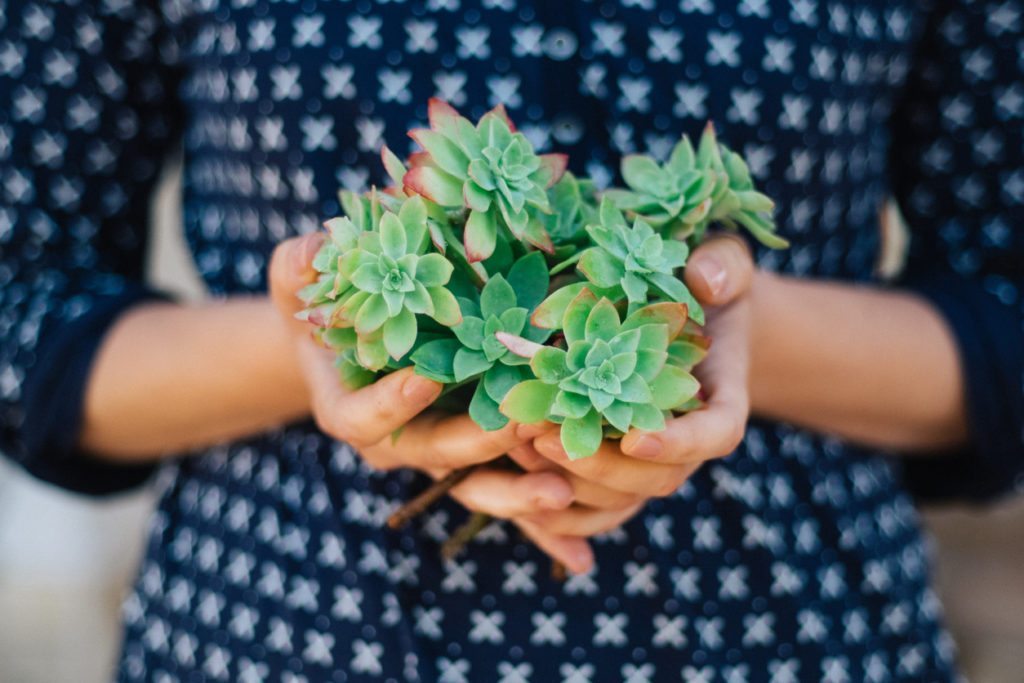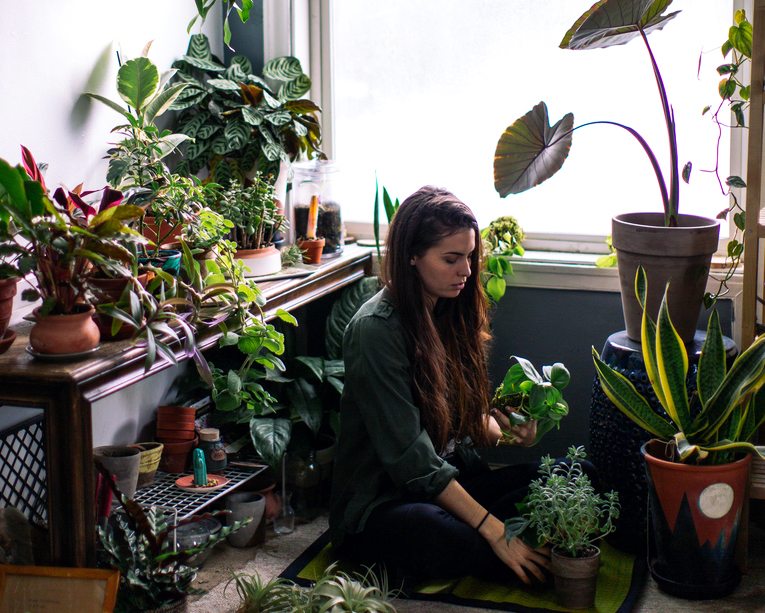It’s no longer a secret that plants promote wellness, with numerous studies exploring the health benefits of being surrounded by greenery. Adding plants to your home will not only make it look amazing, but enhance your mood and encourage clarity too.
Can plants make people happier?
Absolutely, plants make people happier! The act of choosing, nurturing and watching your plants grow is incredibly therapeutic and gratifying. Aesthetically, greenery softens the hard edges of our spaces and is more soothing to the eye. There are also a plethora of studies that show that nature and indoor greenery benefit us both physically and emotionally.
The NASA Clean Air Study shows that many indoor plants purify the air we breathe, making for a cleaner, healthier environment. Other studies have shown that indoor plants help improve productivity and concentration and general mood, a huge bonus in an office environment. A 2011 study on the benefits of indoor plants on attention capacity showed that the existence of plants acted as a kind of ‘attention restoration’ and lowered levels of fatigue. They’ve also been some studies that show that proximity to plants can improve recovery rates post-surgery.
What are some of the other benefits of being a plant owner?
There is something immensely gratifying about a thriving indoor plant that is constantly throwing out fresh leaves. Knowing you are providing it with all it needs to remain happy and healthy is super rewarding. The interaction with our plants, through watering and tending to them can prove very calming. It’s an activity that gets us away from our screens and interacting with nature, a rarity in our busy urban lives.
What is your number one tip for caring for plants?
Finding the indoor plants that best suit the conditions of your space and your lifestyle is essential. Meeting the basic requirements of a plant in terms of light, temperature and ventilation goes a long way to keeping a plant happy and healthy. No matter how much you want an indoor cacti collection, unless your space is flooded with sun they’re really going to struggle.
If someone lives in parts of Australia or New Zealand with particularly hot summers, what types of plants would you recommend?
Succulents and cacti make great indoor plants for hot sunny spots as they generally require less water and can withstand greater temperatures. Some great examples are bunny ear cactus (Optunia microdasys) and the elegant Mexican snowball (Echeveria elegans). Some foliage plants are hardier than others, including Arrowhead vine (Syngonium podophyllum), Pothos (Epipremnum aureum), and different varieties of Philodendron and Ficus. Nearly unkillable is the Zanzibar Gem which I’ve seen go without water for a couple of months! Generally though, it’s good to keep your plants on a regular watering schedule and this should help them through those warmer months. Moving plants further away from windows (beware of heat coming through glass) and ensuring they have enough fertiliser to give them that extra boost is also a great tip for summer.
What are your top style tips for plants?
Plants have a way of completely transforming a space. As a general rule it’s good to create depth, focal points, and interesting shapes. Botanical styling is about being true to your taste and creating something unique, whether that’s a wild jungle or something with just a hint of greenery, play around try different things and see what works best for you. Choosing pots to suit your general aesthetic is important. We always choose pots that work harmoniously but aren’t necessarily matching. Aged terracotta pots work really well with succulents and cacti, and big straw baskets for bigger plants are not only beautiful but make lugging the heavier plants around much easier. Just be sure to line the basket with a plastic wrap or place a plate underneath your plant to catch any water run off.
We love grouping plants together for extra impact. Be sure to take into consideration the shapes of the plants you’re playing with. Are they upright, bushy or trailing? What sort of textures are the leaves, what patterns do they make? How do the colours and variations work together? It’s great to mix textures, colours and shapes to create a stunning vignette. Place lush leaves next to more structural stunners, ensuring your plants don’t sit in a straight line, uneven is always a good number.
What would your advice be for people who are giving up on plant-keeping after failed attempts?
Persevere! Plant casualties can be discouraging and a real knock to one’s confidence but they happen to even the most experienced of plant owners. The important thing is to learn from any plant deaths and try not to repeat the same mistakes. Keeping an indoor garden is one big experiment. Look at what’s not working or what might have gone wrong and take that knowledge into future plant endeavours. Perhaps you’re keeping the wrong plants for the conditions in your space or are killing them with kindness through over-watering. Whatever it is, see a plant death as an opportunity to learn something.

Living With Plants
Even the hardiest of plants are living things that need care and attention to keep them happy and healthy. In this section, we’ll talk you through the basics: water, light, temperature, humidity, soil and fertiliser, and how to select the right pot. Armed with the basics, we hope you will have the confidence to grow a thriving indoor jungle and become the plant parents you were destined to be.
Where to start
There are a couple of factors you need to consider before purchasing your first indoor plants. The absolute best way to ensure a happy and healthy indoor plant is to make sure it gets the light it needs to thrive. If you’re desperate for a cactus but your living room is devoid of any natural light you’re going to end up with one very sad-looking prickle. Save any sun worshippers, such as cacti or a Bird of paradise for the windowsill or a sunny balcony.
It’s important to consider the environment of your home. Do you live in a tropical climate? Or somewhere more crisp and cool? How much light do different parts of your home receive? Are you an attentive plant parent or someone who maybe forgets about the little guys every now and then? Trust us, there’s a plant for all of these scenarios.
Prime position
Once you’ve assessed the light and temperature conditions of your space, it’s time to work out exactly where your new foliage will go. Your chosen space will affect the size and shape of the plant you’ll be looking for. If you’ve got some shelves calling out for a little green attention, you might choose a trailing plant that cascades down towards the ground. Or perhaps you have a neglected corner that’s perfect for a larger statement plant.
In any case it’s time to get inspired. These pages are filled with gorgeous green spaces, ideas for displaying and styling indoor plants and plenty of plant profiles to help you pick out the perfect foliage for building your indoor jungle. Look to magazines, search the interwebs and scope out your friends’ houses; greenspiration is really all around.
Time to shop
So, you’ve decided on the plant of your dreams and now it’s time to track it down. Head to your local nursery and check out some of the foliage in the flesh. You may have a particular plant in mind, but it’s also good to see what’s looking its absolute best. Glossy, vibrant leaves, fullness in shape and fresh leaf growth are all signs of a super-healthy plant. Opting for anything that looks less than perfect will potentially lead to heartache down the road.
Home time
It’s exciting to finally get your new plant purchases home, and it can be very tempting to introduce them to their green siblings as soon as possible. However, hold fire. It’s best to give any new plants a short period in quarantine to ensure that there are no pests or diseases lurking that could spread to your other plants. It’s important to provide the same conditions the plant will have in its chosen spot, and try and get into a regular watering schedule from the get-go. It’s not uncommon for plants to experience a level of stress from being moved to a new location. Leaving the luxury of a greenhouse where they are enjoying prime growing conditions and being subjected to lower light and humidity levels than they’re used to can cause some initial leaf loss. Don’t be too concerned if a few of the lower leaves drop off, but if this persists it may be that the spot you’ve chosen isn’t giving your plant the right conditions it needs to thrive. Plants generally like to remain in one spot, but don’t be afraid to shift them around until you find the place where they can live their best life.
Once your plant is set up, it’s probably only now that the responsibility of caring for this precious piece of foliage really starts to sink in, along with, potentially, a bit of panic. But trust us, you’ve got this! Read on plant parents, and you will be armed with all that you need to know to enjoy a long and happy life with your new plant family!
READ MORE
5 Amazing Health Benefits of Gardening
Suffering From Asthma? Plant A Tree
Indoor plants to clear your air
Are Rooftop Gardens The Way Of The Future?







